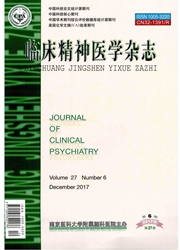

 中文摘要:
中文摘要:
目的:探讨SLC25A12基因单核苷酸多态性(SNP)与孤独性障碍的遗传关联性。方法:采用聚合酶链式反应和DNA芯片杂交技术,在124个汉族孤独性障碍患儿核心家系中,检测了SLC25A12基因的2个SNP位点(rs2056202,rs2292813),采用传递不平衡检验(TDT)和单倍型的方法进行关联分析。结果:在124个患儿核心家系中,所测得的2个SNP位点的等位基因和基因型的频数分布均符合Hardy-Weinberg平衡检验(χ^2=0.009,P=0.92;χ^2=0.006,P=0.94)。而且这2个SNP处于一个强连锁不平衡区域(D’=0.842,r2=0.566)。对124个核心家系TDT检验,发现带有杂合子基因的父代优先传递给子代的等位基因的传递率和此传递率的置信区间差异无显著性(P〉0.05);所有样本的2个SNP位点,未发现与孤独性障碍的显著关联。结论:SLC25A12基因可能不是这些汉族家庭儿童孤独性障碍的主要易感基因。
 英文摘要:
英文摘要:
Objective: To investigate the association between SLC25Al2 gene single nucleotide polymorphisms(SNP) and the susceptibility to autistic disorder. Method:The polymerase chain reaction (PCR) and DNA microarray hybridization technique were used to test two loci of SNPs (rs2056202, rs2292813 ) at SLC25A12 gene in 124 chinese han genealogy with family autistic disorder. Transmission disequilibrium test and haplotype analysis were preformed for the correlation studies. Results: There was no deviation from Hardy-Weinberg disequilibrium for frequency distribution of allele and genetype in the two loci of SNPs ( x^2 =0. 009, P= 0.92; x^2 =0.006,P=0.94). The two loci of SNPs were in strong linkage area of disequilibrium (D' = 0. 842, r^2 = 0. 566). No significant difference appeared in transmission rate of allele, which preferentially came from father with heterozygote gene, and its confidence interval ( P 〉 0.05 ). No significant association was showed between the two loci of SNPs and autistic disorder for the all sample. Conclusion: SLC25A12 gene may not be a major susceptible gene for these chinese han families with autistic disorder.
 同期刊论文项目
同期刊论文项目
 同项目期刊论文
同项目期刊论文
 Gender difference in hemodynamic responses of prefrontal area to emotional stress by near-infrared s
Gender difference in hemodynamic responses of prefrontal area to emotional stress by near-infrared s Detecting effective connectivity in human brain using Granger causality. Proceedings of the 1st Inte
Detecting effective connectivity in human brain using Granger causality. Proceedings of the 1st Inte Hui Gong, Qingming Luo, Zuhong Lu.Differential Hemodynamic Response of Prefrontal Area for Men and W
Hui Gong, Qingming Luo, Zuhong Lu.Differential Hemodynamic Response of Prefrontal Area for Men and W Detecting Directional Influence in fMRI Connectivity Analysis using PCA and Granger Causality. 2008,
Detecting Directional Influence in fMRI Connectivity Analysis using PCA and Granger Causality. 2008, 期刊信息
期刊信息
